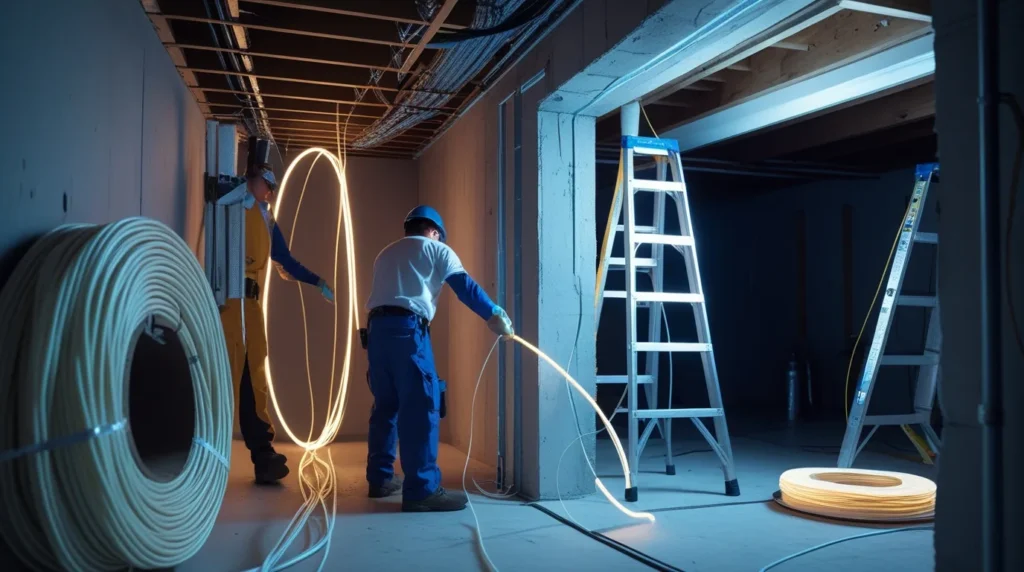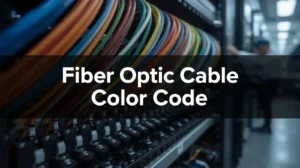Why Fiber Optic Cabling Matters in Modern Installations
Fiber optic cables are the backbone of today’s internet, TV, and phone systems. They help move information very fast, using light instead of electricity. This makes fiber faster and more reliable than older copper wires. Many homes, schools, hospitals, and offices use fiber optics now.
Fiber optic cables are thin, flexible strands of glass or plastic. Inside each strand, light travels in straight lines and bounces off the cable walls to stay inside. This light carries huge amounts of data. That’s why we can watch movies, make video calls, and play online games without much delay.
But fiber optic cable needs to be handled with care. If bent or twisted too much, the cable may not work well. When that happens, your internet might slow down or stop. That’s why cable installers must follow special rules and techniques to make sure everything works smoothly for a long time.
Understanding How Fiber Optic Cables Are Installed

Let’s start with how fiber optic cables are put in place. You might be wondering, how is fiber optic cable installed? First, workers plan the route. They decide where the cable needs to go, such as through walls, underground, or across ceilings. They then measure distances to make sure they use the right cable length.
After planning, they begin the job by feeding the cable through tubes or conduits. This is done carefully so that the cable doesn’t get twisted or damaged. In some cases, workers use machines to pull the cable long distances. In homes, the cables are often run through crawl spaces or attics.
It’s important to protect the cable from sharp objects, tight spaces, or heat. All of these can damage the cable and cause it to fail. Even things like nails in the wall or tight corners can affect how the cable performs.
The Basics of Fiber Optic Cable Bending Radius
Now, let’s talk about the main topic fiber optic cable bending radius. What does it mean? The bending radius is the smallest circle you can bend the cable into without hurting it. Think of it like trying to bend a garden hose. If you make the curve too tight, water won’t flow. The same thing happens with fiber cables and light.
If you bend the cable too much, it puts stress on the inside glass or plastic. When light can’t travel straight, the data it carries gets lost. This causes slow speeds, weak signals, or dropped connections. In worse cases, the cable might crack inside, and you won’t see the damage from the outside.
Cable makers always share the minimum bending radius for cables in their manuals. For example, some fiber cables need at least a 10-inch bend. Others may need more. If the installer doesn’t follow this rule, the cable can become useless, even if it looks fine.
What Is the Minimum Bending Radius for Cables?
The minimum bending radius for cables is the smallest curve you can safely bend a cable. It’s different for each type of cable, depending on size, material, and how it is made. A common rule is to never bend a fiber optic cable more than 20 times its diameter.
Let’s say your cable is 6mm thick. Multiply that by 20, and you get 120mm. That means you should never bend it in a circle tighter than 120mm across. If you do, it might cause damage inside, even if you don’t see it outside.
When cables are placed in corners or around poles, workers use clips and cable guides to keep the bends soft and wide. They also avoid sharp turns when pulling the cable through pipes or boxes. This keeps the fiber safe and working at full speed.
Even when coiling cables for storage, installers leave enough space between loops to protect the bend. Learning to follow the correct bending radius is one of the first skills a new fiber installer must learn.
Why Bending Radius Affects Fiber Optic Cable Damage
Bending a fiber cable too much can cause real damage. The light that moves inside the cable hits the walls and bounces. If the curve is too sharp, the light can escape. This weakens the signal and causes delays or dropped connections.
Think of the cable like a flashlight beam going down a tunnel. If the tunnel suddenly turns sharply, the beam won’t make the turn. It hits the wall and gets lost. That’s what happens to light inside a badly bent fiber cable.
Also, repeated bending—like stepping on the cable or folding it over and over—can weaken the inside. Even if the cable looks okay from the outside, it may have small cracks or breaks inside. This can cause slow speeds or complete loss of signal.
To avoid fiber optic cable damage, always follow the bending rules. Never force the cable around tight corners. Always check for smooth paths and wide turns when planning the layout.
Best Practices for Installing Fiber Optic Cable
When it comes to installing fiber optic cable, professionals follow key rules:
- Plan Before You Start: Know the full route before you lay a single foot of cable. Use maps or building layouts to avoid surprises.
- Avoid Sharp Turns: Always use wide curves. Tight turns increase the risk of breakage.
- Use Cable Management Tools: Clips, trays, and cable ladders help keep bends soft and safe.
- Avoid Pulling Too Hard: Use the correct tools and limit how much tension is applied.
- Protect From Heat and Pressure: Don’t lay fiber near heaters or crush it with heavy objects.
Teams like Heritage Cabling always stick to these steps when they install fiber optic cable. We use the right gear and training to protect your system from damage and future problems.
Planning Your Optical Fiber Installation: Tools & Techniques

Smart fiber work starts with smart planning. This includes knowing the building type, cable type, and how far the signal needs to go. Whether it’s a home or a large office, the layout must be safe, simple, and strong.
Professionals use bend radius gauges, fiber reels, and guides to measure their bends. These tools ensure they never go below the minimum bending radius for cables. They also check corners, wall holes, and entry points to make sure there’s room for smooth turns.
Sometimes, the installer has to install cable through narrow conduits. In these cases, any rope used for pulling cable through conduit should be soft, coated, and designed for fiber jobs. Rough ropes can scratch or pinch the cable, which may lead to signal loss or fiber failure.
Each project is carefully measured and adjusted to make sure every part of the cable route is safe and smooth.
Smart Ways to Run and Lay Fiber Cables Safely
Laying or running cable may seem simple, but it’s a job that takes care and focus. When it’s time to lay fiber optic cable, workers avoid areas where damage could happen. This includes avoiding busy hallways, driveways, or spots with sharp corners.
Installers may run the cable through walls, under floors, or above c. In homes and offices, they use plastic guides or tubes to protect the cable and keep the bends wide. If a turn is too sharp, they adjust the route.
The installer also makes sure not to exceed the fiber optic cable length for that system. Longer runs need stronger cable or extra equipment to boost the signal. This is part of what makes a great fiber plan.
Using Conduits the Right Way During Cable Install
Conduits are strong tubes that protect cables from damage. They are often used underground or behind walls. While using conduits helps protect the cable, it also makes the fiber optic cable bending radius even more important.
When pulling the cable through a conduit, you must use smooth, fiber-safe rope. Remember: any rope used for pulling cable through conduit should be smooth and without sharp edges. Never use wire or metal to pull fiber cables.
Installers also check the inside of the conduit for bends or narrow spaces. If it’s too tight, they may use a bigger conduit or change the cable path to keep it safe.
Understanding Fiber Optic Cable Length and Its Limits
All fiber cables have a limit to how far they can run without losing signal. This is known as the fiber optic cable length max or the fiber cable length maximum. For short runs, like inside a house, standard cables work well.
For longer runs—like between buildings or across campuses—installers must use high-quality cable and sometimes add equipment to boost the signal.
Here are a few helpful numbers:
- Simple home setups: up to 100 meters
- Large offices: up to 500 meters
- Outdoor or industrial runs: 2 kilometers or more with signal repeaters
Asking how far can a fiber optic cable be run is an important part of planning. If you go too far, the signal may become too weak to use. That’s why a good installer always measures twice and checks the specs before starting.
Heritage Cabling’s Trusted Approach to Fiber Optic Cable Installation in Dallas, TX
At Heritage Cabling, we bring experience, care, and precision to every job. From homes to businesses, we know how to handle fiber the right way—following all safety and bending radius guidelines from start to finish.
We train our team to measure each turn, avoid tight bends, and protect your investment from damage. Whether it’s fiber optic cable installation in a school, office, or retail space, we know what it takes to keep your signal strong and steady.
Our team proudly serves Dallas, TX with high-quality service, expert tools, and a strong focus on getting every detail right. We treat your fiber like it’s our own—carefully, safely, and professionally.
Let Heritage Cabling help you get the reliable fiber connection you need. Contact us today to book a consultation or learn more. We’re ready to make fiber simple, safe, and strong for you.




